
The Scottish Campaign for Nuclear Disarmament (Scottish CND) campaigns for the abolition of nuclear weapons and is one of nine partner organisations of the International Campaign to Abolish Nuclear Weapons (ICAN) active in Scotland.

The Scottish Campaign for Nuclear Disarmament (Scottish CND) campaigns for the abolition of nuclear weapons and is one of nine partner organisations of the International Campaign to Abolish Nuclear Weapons (ICAN) active in Scotland.
The organisation was founded in 1958.
On 17 November 2012, as part of a long history of supporting the Scottish independence movement, [1] Scottish CND's Annual Conference passed a resolution, stating:
Conference urges all members to give priority to the campaign for a 'YES vote' in the 2014 Independence Referendum which will give the Scottish Government a mandate to negotiate a written constitution with a clause on No Nuclear Weapons in Scotland. Conference resolves that SCND affiliates to and promotes the “Yes” Campaign as the most immediate and effective way of getting rid of Trident. [2]
During May 2014, the Electoral Commission registered the organisation as a campaigning participant for a "Yes" vote in the September 2014 independence referendum and Chair Arthur West said that the registration process was a display of transparency regarding the CND's involvement with the campaign, further explaining: "This decision was taken because our purpose as an organisation is to promote nuclear disarmament and we believe that independence offers the best opportunity for this." [2]
The Scottish CND's office is in the city of Glasgow, and is the base for protest organising for Glasgow, Edinburgh and Faslane. As of June 2014, the Chair of the organisation is Arthur West, while the Co-ordinator is Flavia Tudoreanu. Other staff include Campaign Worker Emma Cockburn and Administrative Assistant Cristina Albert. [3]
The organisation has released numerous written resources to support its cause, including an April 2014 leaflet and poster, entitled "No Nuclear Weapons Here". The front of the leaflet reads "Scotland no place for nuclear weapons" underneath the title, while the back of the leaflet explains the situation in the UK, stating "Nuclear disarmament begins at home". The Scottish CND also provides people with the option to order free anti-nuclear stickers that are written in English, Scots and Gaelic languages. [4] [5] [6]
The Her Majesty's Naval Base Clyde lies on the western coast of Scotland, 40 km (25 mi) west of Glasgow in the Faslane area. A nuclear submarine fleet is based at the site, [7] facilitated by Prime Minister Clement Attlee's authorisation of a British nuclear weapons programme in 1947. A 1958 agreement between the UK and the United States (US) was followed by a 1962 US agreement, whereby it provided information about its submarine-launched missile system, "Polaris". The UK's first Polaris submarine, HMS Resolution, was launched in 1968 and the entire system was modified in the early 1970s to the British "Chevaline" system. [8]
Then, in 1980, the Thatcher Government purchased the new "Trident" missile system from the US to replace Chevaline and this was finalised in 1996. [8] Submarines carrying Trident nuclear warheads are based at HMNB Clyde and the Scottish National Party affirmed that it would remove the submarines if independence was gained following the 2014 referendum. While experts suggested that the submarines could be relocated to a Devonport base in the English city of Plymouth, the Scottish CND advocates for the complete abolishment of the Trident warheads. [7]
In January 2013, the Scottish CND released a report in which it stated that a much greater population would be put at risk if the weapons were transferred to Devonport. The report claimed that, in the event of an accident at Devonport, an estimated 800 people would be killed by leaking plutonium, while as many as 11,000 people could die from radiation poisoning If the weather was calm. Ainslie further explained to the media that an accident would mean "a large proportion of the city would be abandoned for hundreds of years." A Ministry of Defence spokesperson responded to the discussion and report in January 2013, by stating:
We are therefore not making plans to move the nuclear deterrent from HM Naval Base Clyde, which supports 6,700 jobs, and where all of our submarines will be based from 2017 ... The government is committed to maintaining a continuous submarine-based nuclear deterrent and has begun the work of replacing our existing submarines. [7]
In campaign material released in April 2014, the Scottish CND explained that "All British nuclear weapons are in Scotland" and "a total of 120 nuclear warheads on Trident submarines" are based at the HMNB Clyde in Faslane. [6]
Following the release of the Love album in 1987, Scottish band Aztec Camera was invited to perform at a benefit concert for the Scottish CND in the late 1980s. Frame explained in a television interview prior to the concert that he was merely the entertainment and would not deliver any speeches. [9]
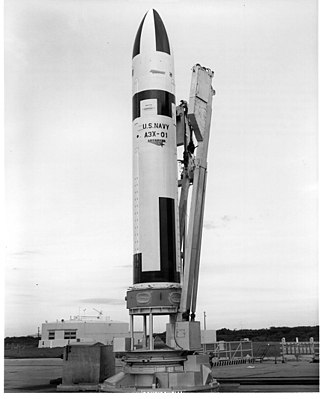
The UGM-27 Polaris missile was a two-stage solid-fueled nuclear-armed submarine-launched ballistic missile (SLBM). As the United States Navy's first SLBM, it served from 1961 to 1980.
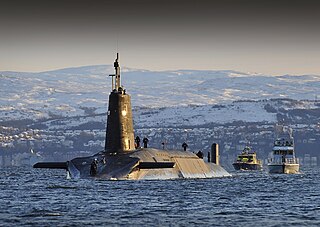
The Vanguard class is a class of nuclear-powered ballistic missile submarines (SSBNs) in service with the Royal Navy. The class was introduced in 1994 as part of the Trident nuclear programme, and comprises four vessels: Vanguard, Victorious, Vigilant and Vengeance, built between 1986 and 1999 at Barrow-in-Furness by Vickers Shipbuilding and Engineering, now owned by BAE Systems. All four boats are based at HM Naval Base Clyde , 40 km (25 mi) west of Glasgow, Scotland.

Chevaline was a system to improve the penetrability of the warheads used by the British Polaris nuclear weapons system. Devised as an answer to the improved Soviet anti-ballistic missile defences around Moscow, the system increased the probability that at least one warhead would penetrate Moscow's anti-ballistic missile (ABM) defences, something which the Royal Navy's earlier UGM-27 Polaris re-entry vehicles (RVs) were thought to be unlikely to do.
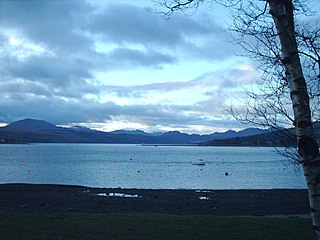
The Gare Loch or Gareloch is an open sea loch in Argyll and Bute, Scotland and bears a similar name to the village of Gairloch in the north west Highlands.

The eleventh HMS Vanguard of the Royal Navy is the lead boat of her class of Trident ballistic missile-armed submarines. The submarine is based at Faslane, HMNB Clyde, Argyll, Scotland.

His Majesty's Naval Base, Clyde, primarily sited at Faslane on the Gare Loch, is one of three operating bases in the United Kingdom for the Royal Navy. It is the navy's headquarters in Scotland and is best known as the home of Britain's nuclear weapons, in the form of nuclear submarines armed with Trident missiles.

In 1952, the United Kingdom became the third country to develop and test nuclear weapons, and is one of the five nuclear-weapon states under the Treaty on the Non-Proliferation of Nuclear Weapons.

HMSVictorious is the second Vanguard-class submarine of the Royal Navy. Victorious carries the Trident ballistic missile, the UK's nuclear deterrent.
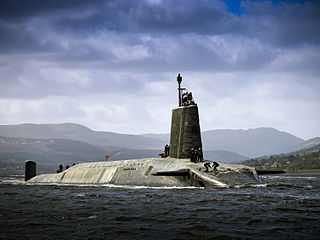
HMSVigilant is the third Vanguard-class submarine of the Royal Navy. Vigilant carries the Trident ballistic missile, the United Kingdom's nuclear deterrent.
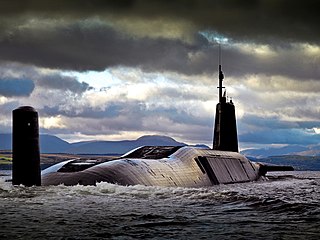
HMS Vengeance is the fourth and final Vanguard-class submarine of the Royal Navy. Vengeance carries the Trident ballistic missile, the UK's nuclear deterrent.

Royal Naval Armaments Depot Coulport, shortened to RNAD Coulport, on Loch Long in Argyll, Scotland, is the storage and loading facility for the nuclear warheads of the United Kingdom's Trident programme.
Defence Nuclear Material Transport Operations refer to the movements of military Defence Nuclear Materials (DNM) within, to and from the United Kingdom. Defence Nuclear Material Transport Operations are also known as DNM Transportation; Defence Nuclear Material in transit; Nuclear movements; and DNM movements.

The Dreadnought class is the future replacement for the Vanguard class of ballistic missile submarines. Like their predecessors they will carry Trident II D-5 missiles. The Vanguard submarines entered service in the United Kingdom in the 1990s with an intended service life of 25 years. Their replacement is necessary if the Royal Navy is to maintain a continuous at-sea deterrent (CASD), the principle of operation behind the Trident system.

Trident, also known as the Trident nuclear programme or Trident nuclear deterrent, covers the development, procurement and operation of nuclear weapons in the United Kingdom and their means of delivery. Its purpose as stated by the Ministry of Defence is to "deter the most extreme threats to our national security and way of life, which cannot be done by other means". Trident is an operational system of four Vanguard-class submarines armed with Trident II D-5 ballistic missiles, able to deliver thermonuclear warheads from multiple independently targetable re-entry vehicles (MIRVs). It is operated by the Royal Navy and based at Clyde Naval Base on the west coast of Scotland. At least one submarine is always on patrol to provide a continuous at-sea capability. The missiles are manufactured in the United States, while the warheads are British.

The anti-nuclear movement in the United Kingdom consists of groups who oppose nuclear technologies such as nuclear power and nuclear weapons. Many different groups and individuals have been involved in anti-nuclear demonstrations and protests over the years.
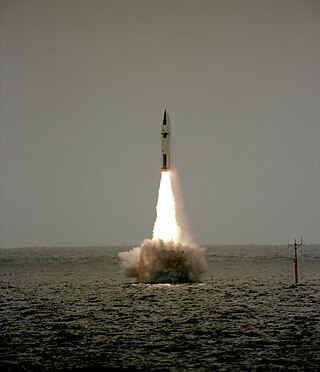
The United Kingdom's Polaris programme, officially named the British Naval Ballistic Missile System, provided its first submarine-based nuclear weapons system. Polaris was in service from 1968 to 1996.

Labour for Independence was a political organisation for Scottish Labour supporters that were in favour of Scottish independence. It claimed to have 2,000 members across Scotland in June 2014. The organisation had been described as an "SNP front" and, following the September 2014 independence referendum, its founder Allan Grogan joined the Scottish Socialist Party.
The 10th Submarine Squadron was an administrative unit of the Royal Navy.

The Campaign for Nuclear Disarmament (CND) is an organisation that advocates unilateral nuclear disarmament by the United Kingdom, international nuclear disarmament and tighter international arms regulation through agreements such as the Nuclear Non-Proliferation Treaty. It opposes military action that may result in the use of nuclear, chemical or biological weapons and the building of nuclear power stations in the UK.